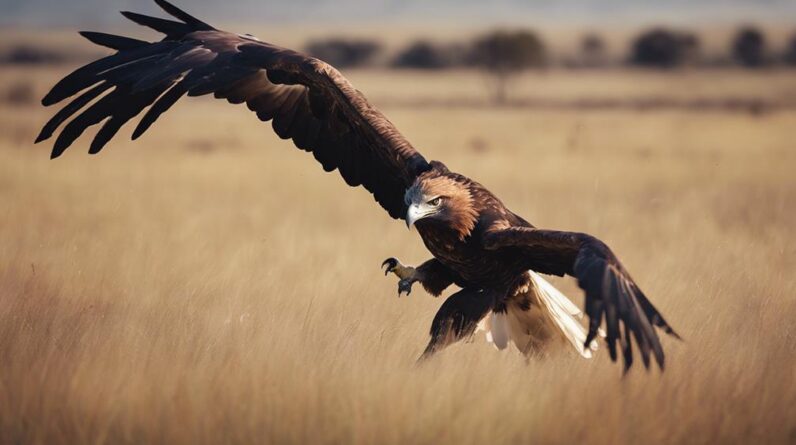
If you've ever pondered the coincidental dance of nature's circle of life, ponder no more. Emus, majestic and swift creatures of the Australian landscape, find themselves entwined in a delicate balance with a host of natural predators. From the stealthy stalkers of the mammalian world to the aerial hunters that soar above, the threats to emus are as diverse as they are formidable. As we explore the intricate web of predator-prey relationships, you'll uncover a world where survival hangs in the balance, and the stakes are higher than you might imagine.
Key Takeaways
- Dingoes and feral dogs are efficient predators of emus, utilizing their pack mentality and hunting skills.
- Wedge-tailed eagles are apex predators that play a significant role in regulating ecosystem balance by hunting emus.
- Goannas and monitor lizards are expert ambush predators, contributing to ecosystem balance by preying on emu eggs and chicks.
- Tasmanian tigers, red foxes, and wild cats are stealthy hunters that pose a threat to emus through ambush techniques.
- Snakes, quolls, and raptors are additional predators of emus, utilizing various hunting strategies to prey on these birds.
Dingoes
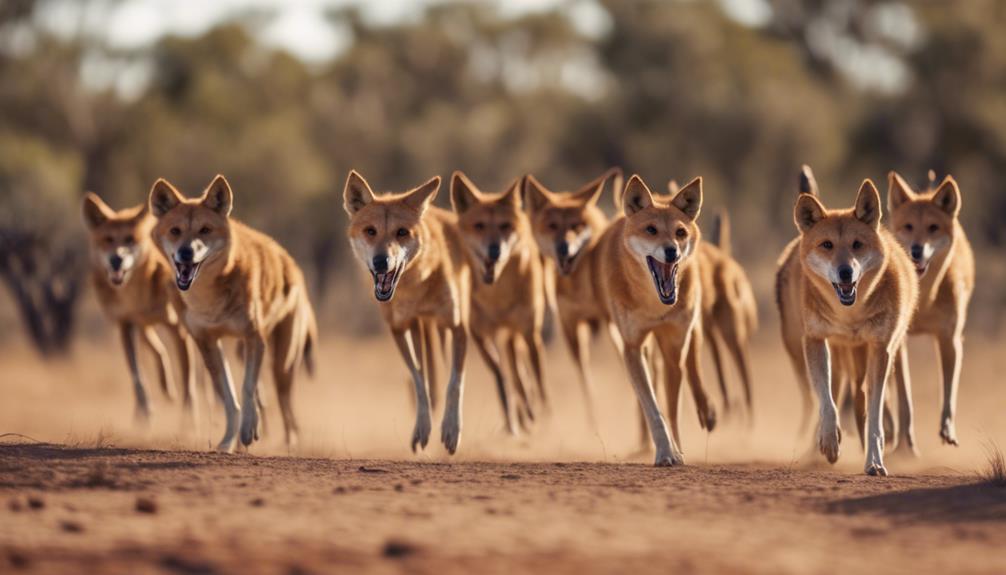
Dingoes are efficient predators known for their stealth and speed in hunting emus. These wild canines, native to Australia, possess a keen sense of smell and excellent eyesight, allowing them to track and pursue emus with remarkable precision. Their lean bodies and strong muscles enable them to swiftly chase down their prey, making them formidable hunters in the vast Australian outback.
With a pack mentality, dingoes often work together to outsmart and corner emus, utilizing tactics that showcase their intelligence and strategic prowess. Their ability to communicate silently through body language and vocalizations enhances their coordination during the hunt, increasing their chances of a successful kill.
When hunting emus, dingoes exhibit remarkable agility and endurance, traits that have been honed through generations of evolution. Their sharp teeth and powerful jaws make quick work of bringing down these large flightless birds, demonstrating the predatory prowess that has allowed dingoes to thrive in the harsh Australian landscape.
Feral Dogs
Feral dogs, also known as wild canines, have been observed to exhibit opportunistic hunting behaviors towards emus in certain regions. These feral dogs, descendants of domestic breeds turned wild, have adapted to survive in various environments, including those where emus roam. Their pack mentality and predatory instincts make them efficient hunters, posing a threat to vulnerable emus, particularly young chicks or injured adults.
Studies show that feral dogs target emus for food, displaying a keen sense of opportunity when encountering these flightless birds. Their speed and agility allow them to chase down emus, often preying on individuals separated from the safety of the group. The impact of feral dog predation on emu populations can be significant, especially in areas where emus face other environmental challenges.
Efforts to control feral dog populations and protect emus are crucial to maintaining the balance of ecosystems where these species coexist. Understanding the dynamics between feral dogs and emus is essential in developing effective conservation strategies to safeguard emu populations from these opportunistic predators.
Wedge-tailed Eagles

Wedge-tailed Eagles, apex predators in the Australian skies, play a significant role in the ecosystem by preying on various animals, including emus. With their keen eyesight, powerful talons, and impressive wingspan reaching up to 2.84 meters, these majestic birds are formidable hunters. Their diet consists of a wide range of prey, from small mammals to larger birds, making emus a viable target due to their size and vulnerability.
Observing a Wedge-tailed Eagle in action reveals a calculated approach to hunting. They soar high above the landscape, using thermal air currents to glide effortlessly and spot potential prey from great distances. Once a target is identified, these predators dive down with astonishing speed and precision, using their sharp talons to grasp and subdue their victim.
In the intricate web of the Australian ecosystem, Wedge-tailed Eagles serve as top-tier predators, regulating populations of various species. Their presence ensures a balance in the environment, showcasing the power these majestic birds hold over the vast Australian skies.
Goannas
Among the natural predators of emus in Australia, goannas play a significant role in the ecosystem with their predatory behavior and hunting strategies. These formidable reptiles are known for their stealth and agility when hunting prey, including the swift and agile emus. Here are some key points about goannas as predators:
- Stealthy Hunters: Goannas are expert ambush predators, using their camouflage and patience to sneak up on unsuspecting prey like emus.
- Powerful Jaws: With strong jaws and sharp teeth, goannas can deliver a swift and lethal bite to disable their prey quickly.
- Climbing Abilities: Some goanna species are adept climbers, allowing them to pursue emus into trees or rocky outcrops where the flightless birds may seek refuge.
- Varied Diet: While emus aren't their primary food source, goannas are opportunistic feeders and won't hesitate to target emu eggs or young chicks when the opportunity arises.
In the intricate dance of predator and prey, goannas stand out as formidable hunters that contribute to the balance of Australia's ecosystems.
Tasmanian Tigers
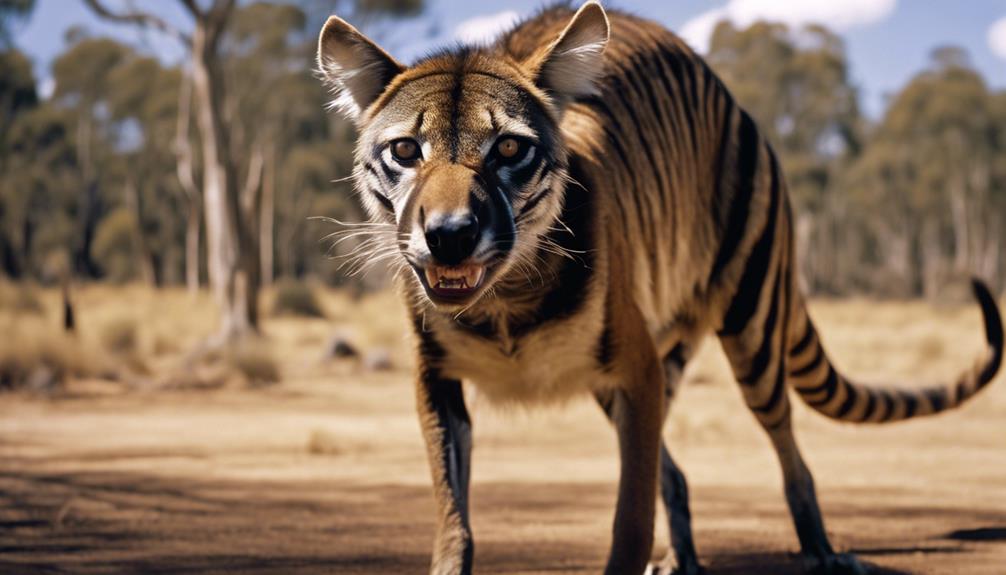
Tasmanian Tigers once roamed the island of Tasmania, showcasing unique behaviors and adaptations that made them intriguing subjects for scientific study. These apex predators, also known as Thylacines, possessed a striking resemblance to canids, yet were marsupials. Their powerful jaws and sharp teeth allowed them to efficiently hunt and take down prey, displaying a level of predatory prowess that commanded respect in their ecosystem.
With distinctive tiger-like stripes running along their back, Tasmanian Tigers blended seamlessly into their surroundings, making them stealthy hunters. Their elongated snouts housed impressive jaw muscles, enabling them to deliver strong, fatal bites to their unsuspecting victims. Despite their intimidating appearance, these creatures were known for their solitary nature, preferring to hunt alone under the cover of darkness.
Unfortunately, due to human intervention and habitat destruction, Tasmanian Tigers were driven to extinction in the early 20th century. Their disappearance serves as a stark reminder of the power dynamics at play in the natural world and the consequences of disrupting them.
Red Foxes
Red Foxes, renowned for their adaptability and cunning hunting strategies, are skilled predators known to thrive in a variety of ecosystems. When it comes to the realm of emu predation, these creatures are formidable opponents. Here's why:
- Stealthy Hunters: Red foxes are experts at moving silently through their surroundings, making them adept at ambushing unsuspecting prey like emus.
- Swift and Agile: Their agility allows them to quickly chase down emus, especially young or injured individuals.
- Sharp Senses: Red foxes possess keen senses of sight, smell, and hearing, enabling them to detect emus from a distance and plan their approach strategically.
- Resourceful Feeders: These predators are known to scavenge for food when necessary, making them adaptable to varying prey availability in emu habitats.
In the intricate dance of predator and prey, red foxes stand out as cunning adversaries, utilizing their natural abilities to secure their next meal with precision and efficiency.
Wild Cats
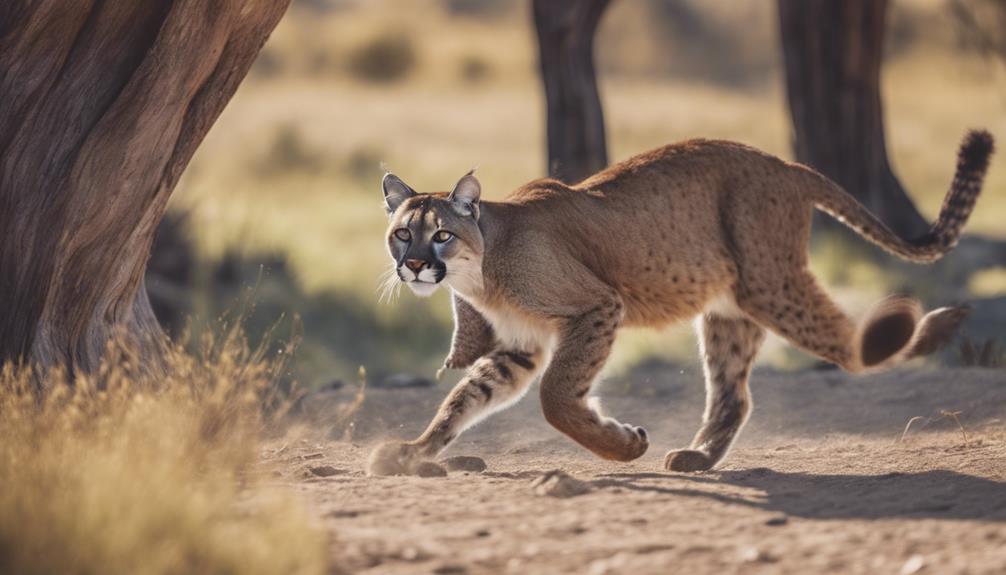
In the realm of emu predation, Wild Cats exhibit remarkable stealth and calculated stalking techniques, positioning them as formidable hunters in the ecosystem. Their sleek bodies, sharp retractable claws, and keen senses make them efficient predators capable of ambushing unsuspecting emus. Wild Cats, such as cougars and leopards, are apex predators with an instinctual drive to hunt and kill. These feline predators rely on their agility and cunning to outmaneuver their prey, making them a significant threat to emus in the wild.
Wild Cats are known for their solitary nature, preferring to hunt alone rather than in packs. This solitary behavior allows them to move silently through their environment, minimizing the chances of detection by their prey. Their ability to blend into their surroundings further enhances their hunting success rate, making them elusive and deadly predators in the wild.
With their powerful muscles and razor-sharp teeth, Wild Cats can deliver swift and lethal attacks, often targeting the neck or vital organs of their prey. Their hunting prowess and adaptability make them a force to be reckoned with in the natural world, posing a serious threat to emus and other prey species.
Snakes
Snakes, as stealthy predators, possess specialized hunting techniques that contribute to their effectiveness in capturing emus and other prey in their natural habitats. When it comes to hunting emus, snakes exhibit remarkable skills that make them formidable predators:
- Ambush Predation: Snakes rely on their ability to remain motionless for extended periods, waiting patiently for an unsuspecting emu to come within striking distance.
- Constriction: Some snake species use constriction as a method to subdue their prey, squeezing the emu with incredible force until it succumbs.
- Venomous Strikes: Venomous snakes deliver quick and lethal strikes, injecting potent toxins into the emu's body, leading to paralysis or death.
- Camouflaging: Snakes are masters of blending into their surroundings, allowing them to approach emus undetected before launching an attack.
In the intricate dance of predator and prey, snakes have honed their skills over millions of years, making them efficient and deadly hunters in the realm of the emu.
Monitor Lizards
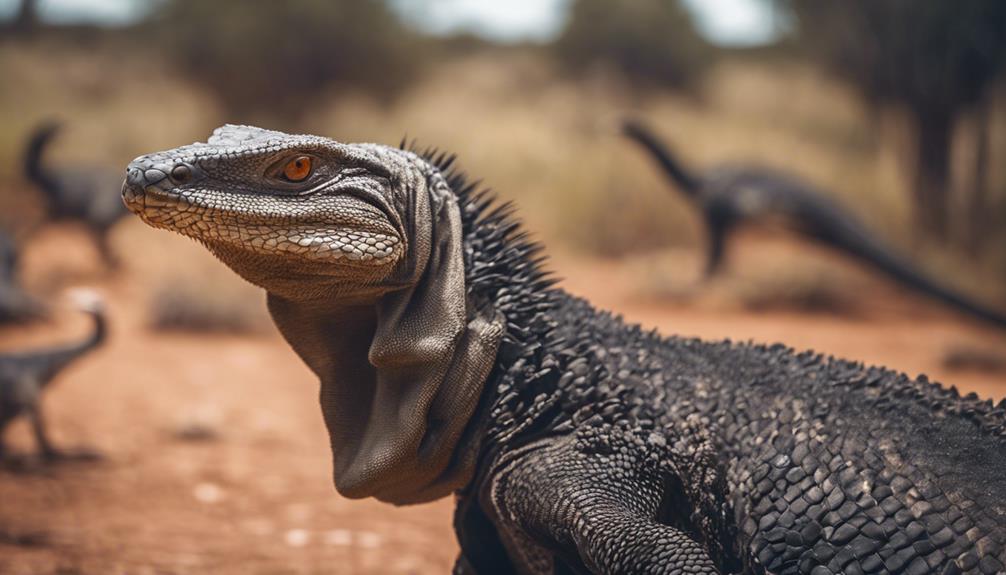
Sleek and agile, monitor lizards possess a predatory prowess that demands attention in the ecosystem they inhabit. These formidable reptiles, known for their keen intelligence and hunting skills, are among the top predators that pose a threat to emus. With their sharp claws, strong jaws, and exceptional speed, monitor lizards are efficient hunters capable of ambushing their prey with precision.
Monitor lizards, with their keen sense of smell and acute vision, are adept at tracking down emus in their natural habitats. Their ability to climb trees and swim adds to their versatility in hunting strategies, making them formidable predators. These lizards, often underestimated due to their reptilian nature, play a crucial role in regulating emu populations and maintaining the balance of the ecosystem.
When encountering a monitor lizard in the wild, one can't help but admire its power and grace. These creatures exemplify nature's strength and complexity, serving as a reminder of the intricate web of predator-prey relationships that shape the natural world.
Quolls
With a voracious appetite and sharp hunting instincts, quolls emerge as significant predators in the ecosystem where emus reside. These agile carnivorous marsupials play a crucial role in maintaining ecological balance by preying on various animals, including emus. Here are some key points about quolls:
- Habitat: Quolls are primarily found in forests, woodlands, and grasslands across Australia, overlapping with the natural habitat of emus.
- Diet: Quolls are opportunistic feeders and consume a diverse diet consisting of insects, small mammals, birds, reptiles, and even fruits. Emu chicks and eggs are also on their menu.
- Hunting Strategy: Quolls are adept hunters, using their sharp teeth and claws to capture prey. They're known for their nocturnal hunting habits, making them elusive predators in the wild.
- Impact on Emu Population: Due to their hunting prowess and ability to adapt to various environments, quolls pose a threat to emu populations, especially targeting vulnerable emu younglings.
In the intricate web of the ecosystem, quolls stand out as formidable predators that contribute to the natural dynamics of emu habitats.
Raptors
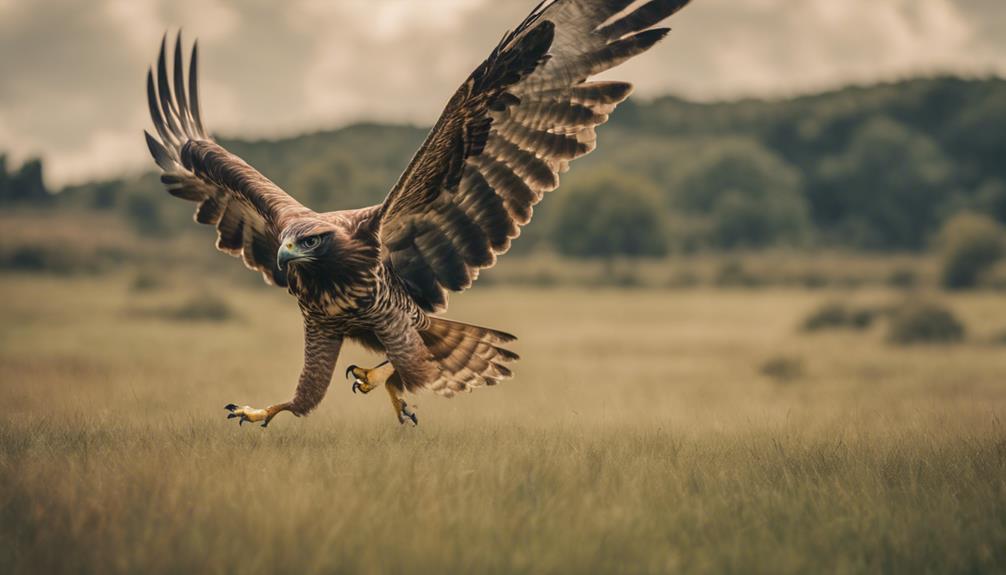
Have raptors established themselves as dominant predators in the emu's ecosystem? Raptors, known for their keen eyesight and sharp talons, play a significant role in the food chain within the emu habitat. These formidable birds of prey, such as eagles, hawks, and falcons, possess the agility and speed to hunt down emus, particularly targeting young or weakened individuals. With their aerial prowess, raptors can swoop down from great heights, catching emus off guard and inflicting fatal injuries with their powerful beaks and talons. Through systematic surveillance of the landscape, raptors identify potential emu prey and execute calculated strikes to secure their meal.
In the intricate web of predator-prey dynamics, raptors have carved out a niche as efficient hunters in the emu's realm. Their ability to soar high above the ground grants them a strategic advantage, enabling them to scan vast territories for emu targets. While emus possess speed and agility on land, they're vulnerable to raptor attacks from the skies. As apex predators in the avian hierarchy, raptors exert their dominance in the ecosystem, shaping the behavior and movements of emus in their quest for survival.
Humans
In the realm of emu ecosystems, humans exert a significant influence on the population dynamics and interactions within this intricate habitat.
- Hunting: Humans have historically hunted emus for their meat, feathers, and oil, impacting their population numbers.
- Habitat Destruction: The expansion of human settlements and agriculture has led to the destruction of emu habitats, reducing their available living spaces.
- Road Accidents: Emus often collide with vehicles on roads built through their habitats, resulting in fatalities that affect their population.
- Climate Change: Human-induced climate change alters the environment and can lead to shifts in food availability and nesting conditions for emus.
These factors, driven by human activities, play a crucial role in shaping the survival and reproduction rates of emus. Understanding and mitigating these impacts are essential for the conservation and sustainable management of emu populations in the face of human pressures.
Frequently Asked Questions
Do Emus Have Any Defense Mechanisms Against Their Predators?
You may find emus intriguing as they lack the typical defense mechanisms like sharp claws or venom. However, their speed and agility are top-notch. Emus can sprint up to 30 mph and swiftly change direction to evade predators effectively.
How Do Emus Typically React When Encountering Their Natural Predators?
When encountering their natural predators, emus typically display heightened alertness, quick movements, and may attempt to flee. Their large size and speed serve as primary defense mechanisms, allowing them to evade danger and protect themselves effectively.
Are There Any Specific Regions Where Emus Are More Vulnerable to Predation?
In certain regions, emus face heightened vulnerability to predation due to factors like habitat loss and human encroachment. Understanding these dynamics is crucial for conservation efforts to protect these majestic creatures.
Can Emus Distinguish Between Different Types of Predators?
You can observe emus' behaviors to determine if they can distinguish between different predators. Their responses to threats and the specific strategies they employ may provide insights into their ability to recognize varying types of danger.
What Impact Do Emus Have on the Ecosystem Due to Predation by Their Natural Predators?
Emus, as prey for natural predators, influence the ecosystem through population control dynamics. Their presence or absence can impact vegetation growth, insect populations, and the overall balance of the ecosystem, illustrating their crucial role in the food chain.
Conclusion
As you observe the interactions between emus and their natural predators, remember that in the circle of life, each species plays a vital role.
Just like the saying goes, 'survival of the fittest,' these predators keep the balance of nature in check, ensuring the health and sustainability of the ecosystem.
So next time you witness a predator-prey interaction, appreciate the intricate web of life that surrounds us all.





